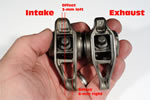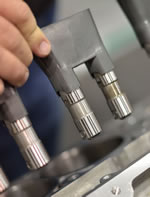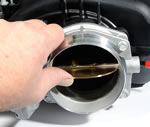Ruthless Pursuit of Power: The Mystique of the C6 Corvette LS7 Engine - Page 15 of 26
Ruthless Pursuit of Power: Lucky Seven Edition: The Mystique of the 7-Liter, 7000-RPM, LS7 - Page 15 of 26
 |
 |
by Hib Halverson
© May 2013— Updated: November 2014
No use without permission, All Rights Reserved
The LS7 rocker arms are made of investment-cast steel, the same material as other Gen 3/4 rockers. The investment casting process is ideal for production roller rockers because it's strong, allows complex shapes with mass only where its needed and is cost-effective. The intake rockers are a unique design with the pushrod seat offset 3-mm to the left and the valve stem pallet offset 6-mm to the right, allowing the pushrod to be moved over to make room for the revised intake port location and shape. Typically, Gen 3/4 Small-Block rocker arm ratios are 1.7:1, however, the LS7 was the first to use a 1.8:1 rocker ratio because it provides more valve lift.
The LS7 rocker design is also unique in some aspects of its geometry. The LS7's 12° valve angle, the extra length of its valves and its higher rocker arm ratio were factored into the design such that the relationship between the valve tip and the rocker arm pivot point is optimized for the LS7. As a result, side loading from the rocker arm acting on the valve is virtually the same as it is for the 15° heads used on other Gen 3/4 V8s.
Lastly, the LS7s valve lifters not only play an important part in the valvetrain's 7100 RPM capability but they are a stalwart design, as well. Other than some occasional small changes in oil metering rates and plunger travel, the part used in a 2013 LS7 is virtually the same part used in 1987, when GM introduced roller hydraulic lifter cams to its engines with the old Corvette L98. The same basic part, in service for 26 years speaks volumes about the soundness of the design.
Induction, Exhaust and Computers
The LS7's intake manifold shares some qualities of previous Gen 3/4 intakes. It's made of black Nylon 6, no coolant flows in it and the throttle body and injectors bolt to it. Other than that, it was a new design. "We had to match to a different port in the cylinder head," John Rydzewski told us. "We tried to get as much flow as possible. The intake runners are sized and tuned for the engine's performance envelope. They're a little bit shorter (than those of LS1, 2 and 6). It's a three-piece, molded and vibration-welded assembly with a seal to prevent crosstalk between runners. It uses a 90-mm throttle body, the biggest we make at GM."
The intake manifold, throttle body, fuel injectors and fuel rail are assembled by a supplier and shipped to the Performance Build Center as one piece. The LS7 uses a "4-bar" fuel system which runs at 400-Kpa or 58-psi. The injectors flow 5-gram/second (39.6 lbs/hr) at 58-psi. They're made by Bosch have all stainless internals--the norm because of ethanol-blended gasolines--and are a ball-and-socket-with-dispersion-plate design.
The air filter assembly designed for the LS7 also holds the mass airflow sensor. It is a low-restriction design with a filter element held by a retainer which screws in place. The filter assembly connects to the engine via a duct or "air bridge." Up until 2012, the filter was a Donaldson "PowerCore" type filter. To reduce restriction and gain back the slight loss in performance forced by the "four cat" exhaust system mandated for 2012 and 2013 by new emissions requirements in California, LS7s were upgraded with the LS9 air filter element which uses the newer, "PowerCore G2" filter media.
The LS7's exhaust manifolds are the most efficient ever used on a production GM V8. They are a two-piece, stainless steel design consisting of a fabricated, stainless steel "shorty header" style manifold, surrounded by a bolt-on or, later, welded-on, hydroformed outer shell which keeps heat in the manifold aiding quick cat light-off. The four, hydroformed primary pipes meet at the manifold's outlet flange. The end of each pipe is a rectangle and are arranged in row which smooths the exhaust flow at the outlet and into a "wide-mouth" catalytic converter. This design contributes to the Z06's low level of back-pressure.
 |
 |





